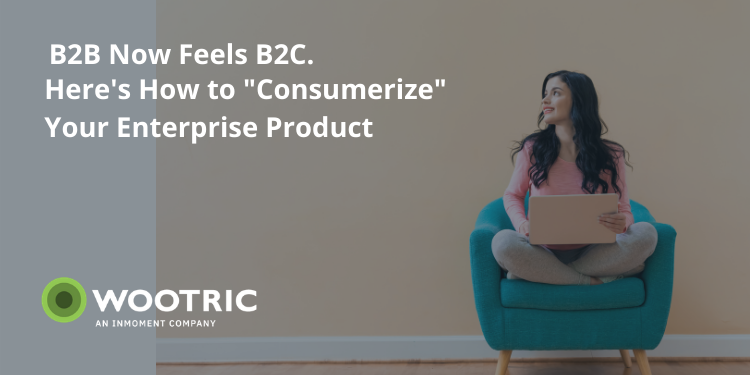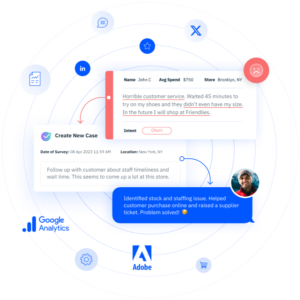B2B Now Feels B2C. Here’s How to Consumerize Your Enterprise Product

Customer expectations drive the value of CX. Continuously meet or exceed expectations, and delighted customers will return and even become vocal advocates for your product and brand.
Don’t let the terms B2C (Business to Consumer) and B2B (Business to Business) confuse you. Your end-user is a human who spends a lot of time on Amazon. They’ve come to expect consumer-level digital experiences at work and play.
Welcome to the consumerization of B2B; your customers have been expecting you.
Whether your company’s releasing an app as part of its digital transformation or it’s a digital-native SaaS company, CX pros need to understand the evolution of the B2B customer experience and make sure their products meet their B2B consumers’ expectations.
The B2B focus: from customer to end-user
B2B encompasses many types of different companies with varying levels of digital experiences. They’re all still dealing with some legacy ideas of B2B as they innovate and strive to keep one foot ahead of customer expectations.
In the not-so-distant past, B2B tech was big. Big machines, big decision-makers, big purchase prices, big buying time, and big onboarding. Tech salespeople wined and dined the VP and C-level buyers through the months-long decision process. Procurement got involved in making sure the tech worked at least “close enough” for the largest number of people at the company. Once the systems were in, they were in for the long-term, and user experience be damned.
Today, the tech is in the cloud, and it’s the little things that are important. Tech choices are researched and made by individuals and teams. Procurement may still get involved, but they come in to find so many people already happily using the software they just need to negotiate contracts vs. deciding “are we going to use Slack or not?” It’s one tech-savvy end-user after another replacing the big buying teams, and the app just needs to let that one person do their specific job faster and better. The sales process is digital, set up is easy, and customer service is a click away.
The newer SaaS companies practicing Product Led Growth (PLG) have grown up in this digital age where everyone’s a consumer. If you are a workhorse platform, how can your digital experiences compete with these disruptors?
12 ways to “consumerize” B2B customer experience
Think of your week’s worth of online consumer experience, and there are some overarching elements of a good CX. From Netflix to Uber, there are elements you need to pull into the B2B experience.
- Freemium or trial access. Appcues found 90% of users want to try a product for free. Can you design a lite but still valuable-to-the-user version of your product? If so, this can be a great lead generation channel. Give marketing adequate development resources and let them run it.
- Fully digital. There’s no need for interaction with a live person to access and use the product. Users expect the app to understand their goals and take them step-by-step through the process to meet their goals.
- Intuitive setup and use. No user wants to have to read an essay on how to get started; it should be one step clicks without confusion. There’s no need to look for what they need, no need to be trained by an admin — it’s right there.
- Quick time to value. The user wants to do their job faster, easier, and better — make that happen quickly before they find another option.
- Easy connections to existing tech. While you’re focused on the individual end-user, don’t forget your app needs to fit into the organization’s workflow, speeding time to value and allowing your power user to advocate for your app. Also, realize that while one user may need everything your app does, others just need to know the results. Make sure your app links to the app others work in the most. If others need the data from your app to work in Slack, then offer a single-click integration to send the data from your app to Slack.
- Simple vs. feature-laden. Keep the interface as decluttered as possible, so it’s easy for users to find what they need. Visual clarity poses a challenge for feature-ladened platforms, so design with a bias toward simplicity. And remember, there will be light users who don’t want to have to figure out, once again, how to run a report. You still need all the features for those power-user admins, but you must also prioritize the light user’s experience.
- Mobile. The more people who adopt your app, the more mobile users you’ll have. While you don’t have to design to be mobile-first, you can offer a simplified version of your desktop platform, keeping all the features someone on the go will need when they’re away from their office.
- Easy to share. People work on teams for the most part, and shared apps help complete shared work. Make it easy for your power user to evangelize and share your product within the organization with a one-click invitation.
- Real-time issue resolution. Digital is fast, and users expect to solve any problems encountered in real-time. Offer help right in the product through a chat function. No one minds AI if it resolves their issue — they just want it handled now.
- Easy to review. Purchase decisions today reflect the power of the end-user. Decisions are made based on word of mouth and 3rd party review sites, so make it easy for your promoters to evangelize for you. Use in-app surveys to identify your happiest customers and then automate the review to link to AppStore or G2 once the survey is completed.
- Seamless upgrade to paid. The freemium or trial offer will demonstrate value. When more functionality is required, make it an easy click to the premium product version.
- Customer feedback. Build improvement and growth into your product by asking for feedback right in the platform and mobile app. Your buyers and end-users expect you to be optimizing your product, so make it easy for end-users to give feedback in the moment through simple NPS, CSAT, and CES micro-surveys.
Designing your digital CX for the modern B2B customer means taking a B2C mindset. Your product isn’t serving a faceless company; it’s serving the individual people who use it. Where are your people? What are their expectations? How can you connect them to value most easily? By designing to help end-users meet their goals, you create a partnership with individuals whose success is based on your product. They will tell you how to improve your product and evangelize its use to develop new customers. Once in, they want to help you make your product better, and their feedback will light the way for your company’s success.
Wootric is CX management for modern B2B companies. Book a consultative demo today.
